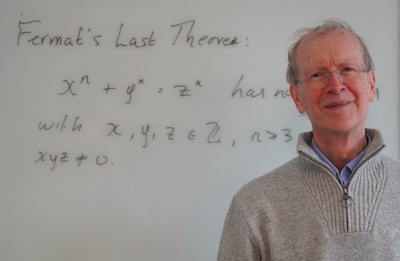
Fermat's last theorem

Andrew Wiles, at the University of Oxford in 2023 (Image courtesy of the INI)
Fermat's Last Theorem is one of the most beguiling results in mathematics. In 1637 mathematician Pierre de Fermat wrote into the margin of his maths textbook that he had found a "marvellous proof" for the result, which the margin was too narrow to contain.
If you look at the theorem you can see why Fermat might have thought that he found an elegant proof: the theorem is easy to explain, even to primary school students. But the proof turned out to be elusive even to the most talented mathematicians. It wasn't until over 350 years after Fermat's scribble that Andrew Wiles announced a proof, after years of working in secrecy and using mathematical machinery that goes well beyond the theorem's humble appearance. When Wiles announced the proof at the Isaac Newton Institute, our neighbour here in Cambridge, the atmosphere, according to eye witnesses, was electric.
To celebrate the thirtieth anniversary of this important moment in mathematical history, we were lucky enough to speak to Andrew Wiles about the theorem and his effort to find the proof, to Tom Körner who was present on that exciting day back in 1993, and to Jack Thorne about the impact of Wiles' proof. Below you'll find the podcast and article from those interviews, as well as a selection of other content that will let you explore the theorem, the proof, and its impact on mathematics. Enjoy!
A very old problem turns 30 — In this article we speak to Andrew Wiles, Tom Körner and Jack Thorne about the history, the proof and the impact of Fermat's Last Theorem.
Fermat's Last Theorem – 30 years on — In this special podcast we look back on this remarkable mathematical moment with Andrew Wiles, Jack Thorne and Tom Körner, and how it opened new doors onto the future of mathematics.
Celebrating 30 years of Andrew Wiles and Fermat's Last Theorem — In this video Andrew Wiles tells us about his experience working on the proof, sharing it with the world, and the exciting mathematics it has led to.
Andrew Wiles: What does it feel like to do maths? — These two videos, and accompanying article, document a fascinating encounter we had with Wiles at the Heidelberg Laureate Forum in 2016. Wiles talks about what it was like to finally prove such an important result and what it feels like to do maths in general — it's a bit like composing a symphony!
Fermat's last theorem and Andrew Wiles — This article looks at the maths behind the proof in a little more detail. (The image shows a portrait of Fermat.)
An interview with Jack Thorne — In this video from the International Congress of Mathematicians (ICM) in 2018, we talk to Jack Thorne about his lecture at the ICM and his work "faceting the gem stone" in number theory.
Ramanujan surprises again — In 2015 two mathematicians discovered a manuscript by another mathematical legend, Srinivasa Ramanujan, and found that he too had been working on Fermat's last theorem.
Answers on a donut: the Fields medal lecture of Manjul Bhargava — In 2014 Manjul Bhargava won the Fields medal, one of the highest honours in maths, for work that's related to the maths behind Fermat's last theorem.
This content was produced as part of our collaboration with the Isaac Newton Institute for Mathematical Sciences (INI) – you can find all the content from the collaboration here.
The INI is an international research centre and our neighbour here on the University of Cambridge's maths campus. It attracts leading mathematical scientists from all over the world, and is open to all. Visit www.newton.ac.uk to find out more.
